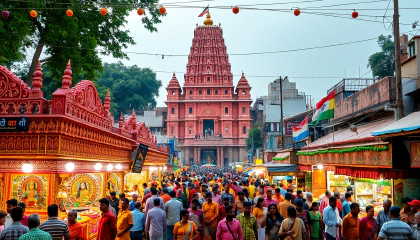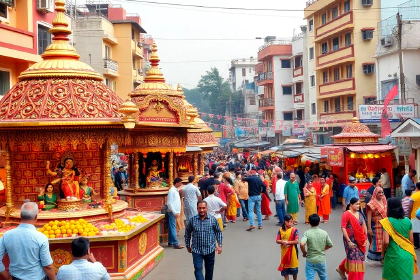
Chittaranjan Park: Delhi's Bengali Heart Evolves
Cultural Legacy and Urban Evolution: A Journey Through Chittaranjan Park, Delhi
Nestled in the heart of South Delhi, Chittaranjan Park (CR Park) stands as a vibrant testament to the resilience and cultural richness of the Bengali community in India’s capital. From its humble beginnings as a refugee settlement to its current status as a thriving cosmopolitan hub, CR Park’s journey mirrors the complex tapestry of India’s post-partition history and urban development. This article delves into the fascinating evolution of this unique neighborhood, exploring its cultural heritage, urban landscape, and the delicate balance it maintains between tradition and modernity.
The Historical Roots of Chittaranjan Park
From EPDP Colony to Cultural Enclave
CR Park’s story begins in the aftermath of India’s partition, when it was established as the East Pakistan Displaced Persons (EPDP) Colony. Originally a rocky, barren area, it was transformed through the determination of Bengali refugees seeking to rebuild their lives.
The Vision of Community Leaders
Key figures like Chandra Kumar Mukherjee and Subodh Gopal Basumallik played crucial roles in advocating for a dedicated Bengali settlement. Their efforts led to the allocation of land in the 1960s, setting the foundation for what would become a thriving cultural enclave.
Evolution of Name and Identity
The colony underwent several name changes, from EPDP Colony to Purbachal, before finally being christened Chittaranjan Park in honor of the Bengali freedom fighter Chittaranjan Das. This evolution in nomenclature reflects the community’s journey from displaced refugees to proud custodians of Bengali culture in Delhi.
Cultural Heartbeat: Festivals and Traditions
Durga Puja: The Crown Jewel of CR Park’s Cultural Calendar
Durga Puja in CR Park is not just a religious festival; it’s a spectacular celebration of Bengali culture that draws visitors from across Delhi. The neighborhood transforms into a mini-Kolkata, with elaborate pandals, traditional music, and mouth-watering Bengali cuisine.
Year-Round Cultural Vibrancy
Beyond Durga Puja, CR Park pulsates with cultural activities throughout the year. From Saraswati Puja to Kali Puja, the community maintains a rich tapestry of Bengali traditions. The Bangiya Samaj and other cultural organizations play a pivotal role in organizing events that keep the Bengali spirit alive.
Culinary Heritage as Cultural Ambassador
CR Park’s food scene is a gastronomic delight, offering authentic Bengali cuisine that has made the area a food lover’s paradise. From street-side stalls selling phuchka to restaurants offering elaborate Bengali thalis, the neighborhood’s culinary landscape is a vital part of its cultural identity.
Urban Landscape and Evolution
Architectural Transformation
CR Park’s urban fabric has undergone significant changes over the decades. The original single-story houses have given way to multi-storied apartments, reflecting the area’s rising property values and changing demographics.
Green Spaces and Community Areas
Despite urban densification, CR Park has managed to preserve its green spaces. Parks like the Mela Ground serve as crucial community spaces, hosting events and providing recreational areas for residents.
Commercial Development
The neighborhood’s markets have evolved from basic necessity stores to vibrant commercial hubs. The four main markets of CR Park not only cater to daily needs but also serve as social spaces where the community gathers and interacts.
Demographic Shifts and Cultural Integration
From Bengali Enclave to Cosmopolitan Hub
While CR Park remains a bastion of Bengali culture, it has also embraced diversity. The influx of non-Bengali residents has added new layers to the neighborhood’s cultural mosaic.
Intergenerational Cultural Transmission
CR Park faces the challenge of preserving its Bengali heritage while adapting to modern urban life. Cultural institutions and schools like the Raisina Bengali School play a crucial role in transmitting cultural knowledge to younger generations.
Case Study: The 1984 Sikh Riots Protection
During the 1984 anti-Sikh riots that engulfed Delhi, CR Park stood out as a safe haven. Bengali residents protected their Sikh neighbors, demonstrating the community’s commitment to secular values and social harmony.
Conclusion: A Model of Cultural Preservation in Urban Settings
Chittaranjan Park stands as a remarkable example of how cultural identity can be preserved and celebrated within the rapidly changing landscape of a metropolis. Its journey from a refugee settlement to a vibrant cultural hub offers valuable insights into urban planning, community building, and the preservation of cultural heritage in diverse urban settings. As CR Park continues to evolve, it remains a testament to the resilience of cultural identity and the power of community in shaping urban spaces.





